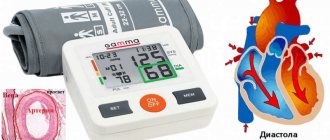Few people probably know that a woman’s body during pregnancy is at the peak of its physiological capabilities. All systems, on the one hand, begin to work harder, at new speeds, fueled by resources that you might not even suspect. On the other hand, pregnancy and childbirth cannot have immunity against those “sores” that you have accumulated by the time you conceive a child. And often these pathologies prevent pregnancy from being physiological and calm.
But sometimes the pregnancy itself goes well, childbirth cannot be called difficult either, but the postpartum period is not without its negative aspects. And one such problem may be high blood pressure after childbirth . Blood pressure also occurs during childbirth (high), and during pregnancy it may happen that for the first time in her life a woman sees unusually elevated values on the tonometer. And each situation needs to be dealt with separately.
High blood pressure in a woman before childbirth
Without further ado, we can say: if a pregnant woman has persistently high blood pressure over a long period of gestation, this is a serious matter. With these symptoms, doctors always suspect gestosis, a specific condition of a pregnant woman that can cause serious problems for both her and the baby. With this pathology, the functionality of a number of organs is upset, and what is especially alarming is that the disease quickly progresses.
High blood pressure before childbirth manifests itself:
- General deterioration in health;
- Hearing dysfunction;
- Flickering of “flies” before the eyes;
- The appearance of hyperemic areas on the skin of the chest or face;
- Vomiting and nausea.
But it happens that hypertension in pregnant women occurs hidden - the woman herself does not feel any special changes. And if she feels any discomfort, she chalks it up to pregnancy. And then the problems are clarified only at a scheduled appointment with a gynecologist, part of which is a mandatory blood pressure measurement. If the doctor sees alarming indicators, he will insist on hospitalization. It is necessary to find out what caused the increase in pressure, whether there is gestosis, and prescribe appropriate therapy.
High blood pressure during pregnancy
Gestational hypertension
It happens that the blood pressure of a woman with an initially normal blood pressure level increases after the 20th week of pregnancy. This is gestational hypertension. If this form of hypertension occurs, then the pressure should normalize within 42 days after birth. If a gestational form of hypertension is suspected, the woman should be further examined.
It is necessary to conduct general clinical blood and urine tests, examine 24-hour urine for protein, perform an ultrasound of the kidneys, an ECG, determine blood glucose, LBC, 24-hour blood pressure monitoring, do an echocardiogram, and examine the fundus. A complete examination will help establish the correct diagnosis, as well as start treatment on time. This will help avoid complications during pregnancy and childbirth, and will also prevent the development of hypertension after childbirth.
Why does gestosis occur?
One-time pressure can also rise in a woman whose pregnancy is not burdened by pathology. But more often, elevated blood pressure for a long time is a sign of gestosis. This condition cannot be treated on an outpatient basis: the expectant mother must be under the supervision of doctors, so hospitalization is indicated for her.
There are many possible reasons for increased blood pressure:
- Stress. Unfortunately, this factor cannot be excluded. Pregnancy itself is associated with a burden on the body, but if this is accompanied by problems at home, at work, or other troubles that cause acute or long-term stress, experiences can turn into a dangerous pathology. The body does not have enough resources for restructuring, and it reacts with pressure surges.
- Heredity. Every pregnant woman should know how her mother and grandmother carried the baby. Very often, maternal birth scenarios are similar. But even if not everything was smooth, do not be alarmed - firstly, medicine does not stand still, and secondly, if you warn the doctor about possible negative heredity, doctors will have time to “lay out straws”.
- History of diabetes mellitus. The disease does not always lead to increased blood pressure in pregnant women, but the risks of gestosis in mothers with diabetes are high.
- Lack of compensatory resources of the patient’s body. For various reasons, a woman’s body may not be able to fully cope with the tasks that pregnancy poses to it. The heart cannot pump blood at a new pace, which is reflected in an increase in blood pressure,
- Poor physical fitness. If you are a mobile, physically active person, moderately trained, it will be easier for your cardiovascular system to cope with new loads. Those who love to replace a walk with lying on the sofa will not have to count on a successful, absolutely calm pregnancy.
- Obesity. For pregnancy, this word is a yoke around the neck. You will have a strong feeling that you are not the mistress of your body, but it does not allow you to do what you really want. If you don’t just have a couple of extra kilos, but a serious increase, and during pregnancy you will inevitably gain at least 10 kg, problems can come one after another. Alas, gestosis is a common diagnosis for obesity.
- Smoking. Nicotine affects various systems of the body and also causes significant damage to the heart muscle and blood vessels. And given that pregnancy puts a serious strain on them, smoking takes away from your health.
- Kidney pathologies. If you have pyelonephritis, then there is a very high probability of increased blood pressure during the months of pregnancy.
- Hormonal imbalance. If there is a malfunction in the “queen of metabolism” of the thyroid gland, if a disorder occurs in the activity of the adrenal glands, the pituitary gland, a hormonal imbalance can cause an increase in blood pressure. This is due to an incorrect hormonal signal, which seems to turn everything in the body’s well-coordinated system upside down.
There are several specific reasons for the development of gestosis. More precisely, there are several medical theories that comprehensively explain what happens in the mother’s body.
Take, for example, the corticovisceral theory. She explains gestosis as a specific neurotic condition with a malfunction of cortical brain structures and a further increase in vascular tone. There is also an endocrine theory: if you rely on it, then an unhealthy pregnancy is a prolonged stress that overstrains all the endocrine points of the body. Their resources are depleted, including those responsible for vascular tone.
If a pregnant woman was diagnosed with arterial hypertension before conception, gestosis is highly likely. How big it is both during multiple pregnancies and at the age limit (carrying a child by a woman under 18 and over 30 years old). If you had gestosis in a previous pregnancy, you cannot rely on the saying about the funnel and the projectile - the pathology, alas, can recur.
Breastfeeding and blood pressure
Many mothers suffer from changes in blood pressure during breastfeeding. It is especially necessary to look after women whose blood pressure problems appeared during pregnancy.
If a mother who is breastfeeding has high or low blood pressure, she definitely needs to know what to do about it, because the active ingredients of medications for hypertension and hypotension tend to penetrate into breast milk.
When increasing
If blood pressure is high, you should adhere to the general recommendations described above. If the situation worsens, first aid for a nursing mother with increased blood pressure is as follows:
- Call an ambulance or your doctor.
- If a woman is taking medications that cause an increase in blood pressure, she should stop taking them (this does not apply to uterotonics).
- Before the doctor arrives, it is best to lie on the couch so as not to harm yourself even more.
- If mom doesn’t have enough air, she needs to open the windows and doors.
Helpful: How to reduce blood pressure while breastfeeding? List of popular drugs prescribed in the maternity hospital: Dopegit, Methyldopa, Nifedipine, Verapamil.
When decreasing
If a nursing mother has low blood pressure, then she should clearly know what to do to normalize blood pressure.
- If this situation arose as a result of nervous tension, then the woman should get a good night’s sleep, namely, at least 8 hours and relax.
Important If you experience low blood pressure during lactation, it is better to consult a doctor!
- When blood pressure drops, massage the neck and back of the head, stretch your fingers, press your fingers on the point between the upper lip and nose
- If there is not enough iron in the blood, it must be compensated. The diet should include fruits, turkey, beef liver, beef, buckwheat, legumes, and lentils.
- If your hemoglobin levels are low, you should walk outside more often.
- If hypotension is caused by a deficiency of thyroid hormones, a woman should consume iodized salt, sea fish, and seaweed.
- If you feel very dizzy, then it is best to lie down and drink sweet tea after feeling dizzy.
Many nursing mothers experience hypertension and hypotension during lactation. These diseases are associated with various factors. General fatigue and deficiency of vitamins and minerals make themselves felt in such an unpleasant way. Hormonal changes and changes in vascular tone also contribute well to the development of these ailments.
This signal from the body indicates that a woman needs a balanced diet, rest, emotional release, and, most importantly, a visit to the doctor.
Development of gestosis and increase in blood pressure before childbirth
The rudiments of the disease form in the early stages of gestation. When the embryo is implanted into the uterine wall, the arteries that are located in the muscle layer do not change. They remain in their usual state. And because of this, their spasm appears, the inner choroid, the endothelium, becomes deformed. And if this same endothelial dysfunction occurs, gestosis starts.
Endothelial dysfunction can be compared to a starting flag - it provokes the release of the strongest vasoconstrictor components. At the same time, such a characteristic of blood as viscosity also increases, and microthrombi form in the vessels in a state of spasm.
Because of this, blood volume decreases and the tone of peripheral vessels increases. The dynamics of blood flow in all central organs - the heart, brain, kidneys and liver - are disrupted. The same is observed in the placenta, which supports pregnancy. So we come to the gestosis clinic.
Classic symptoms of gestosis include swelling, persistently high blood pressure and proteinuria (or protein in the urine).
But such a classic triad is recorded in only 15% of patients; a third of patients complain of one of three symptoms. And, unfortunately, more than half of pregnant women with gestosis are susceptible to protracted forms of the disease.
Normal pressure
Both during the period of bearing a child and after his birth, if a young mother practices breastfeeding, the pressure should be within normal limits, this means that the body can fully cope with the loads, and no pathological changes occur in it. In healthy people, blood pressure should not be lower than or exceed the normal range of 90/60-140/60. Blood pressure can fluctuate within acceptable values; such changes depend on the characteristics of the body, age, weight and many other factors.
Enter your pressure
Move the sliders
120
on
80
How to identify gestosis and assess its severity
The severity of the pathology, if we take the Russian classification as a basis, is marked by the condition of the kidneys. So, first-degree gestosis is swelling of the lower leg, a low protein content in the urine, and an increase in blood pressure to a maximum of 150/90. The child develops normally; this disease is typical at 36-40 weeks.
Preeclampsia of the second degree is already swelling in the abdomen, high proteinuria and an increase in blood pressure to 170/110. At the same time, experts often record grade 1 fetal malnutrition. A similar course most often occurs at 30-35 weeks.
Preeclampsia is treated only in a hospital:
- Therapeutic and protective regime. The patient is given IVs with special solutions, and if necessary, injections are given to correct the condition. They monitor her nutrition, food and bed rest. It is important to keep the situation under control and prevent it from getting worse.
- Restoring the functionality of internal organs. Doctors select restorative therapy that will have minimal impact on the condition of the fetus but will help the woman.
- Delivery. In special cases, gestosis cannot be stopped by anything. After weighing all the factors, possibilities, and risks, doctors decide whether to give birth to a woman.
Typically, in hospital practice, women are prescribed sedatives that gently reduce blood pressure, antihypertensive medications (usually calcium antagonists), and magnesium sulfate. Blood volume is replenished with intravenous infusions. It is possible to prescribe antioxidants and antiplatelet agents.
With a mild degree of gestosis and a low increase in blood pressure, the course of treatment is about 10 days. Average severity does not leave doctors such a long, but moderate distribution of therapy; they must meet the five-day deadline. If gestosis is severe, then doctors have only 6 hours for treatment. If there is no way out, the patient will have to be delivered.
The dangers of high and low blood pressure after childbirth
If postpartum hypertension is not treated in a timely manner, then after 5 years the disease becomes persistent. In addition, there is a high probability of developing other consequences that are dangerous for the mother and even the little baby:
- Excess body weight does not have the best effect on blood supply. As a result, the volume of circulating blood begins to increase, which leads to persistent hypertension.
- There is a high probability of worsening the course of chronic diseases that the woman suffered from before pregnancy.
- The occurrence of frequent headaches negatively affects the quality of breast milk or it disappears altogether.
- There is a high risk of sudden loss of consciousness.
- The heart is constantly working in emergency mode.
- The likelihood of developing pulmonary edema.
- Due to incorrect blood circulation, internal organs constantly experience oxygen starvation.
- Oxygen deficiency leads to increased pulmonary pressure.
- Serious dysfunction of the central nervous system.
- There is poor blood circulation in the mammary glands.
- Milk does not contain nutrients that are beneficial for the baby, which negatively affects his health and growth.
If labor occurs with high blood pressure
Natural childbirth against the background of arterial hypertension is impossible. During labor, blood pressure can rise even higher and reach critical values. This is dangerous for both the baby and the mother in labor.
Can blood pressure rise before childbirth? Yes maybe. Then doctors will take repeated measurements and try medication to correct the situation. If the pregnant woman’s condition has been steadily normalized, she has every chance of giving birth herself. But if the pressure cannot be reduced, there is talk about a caesarean section.
When to expect blood pressure to normalize
Doctors say: high blood pressure in the first few weeks after birth is a normal, expected reaction of the mother’s body to pregnancy. After all, this is both hormonal changes and a load on the cardiovascular system. This includes fatigue, loss of strength after childbirth, and stress.
Also read: Features of hypertension in diabetes mellitus As a rule, blood pressure returns to normal gradually and soon ceases to bother you at all. This happens when a woman gains strength, recovers from childbirth, and adapts to a new schedule. If the woman in labor does not have any abnormalities in the functioning of the body, already at 6-7 weeks the pressure returns to normal.
In other cases, it is necessary to consult a doctor and prescribe effective treatment.
Blood pressure increased after childbirth: what does this mean?
There are many reasons for increased values on the tonometer already in the postpartum period. For example, increased vascular tone can provoke such an unpleasant phenomenon. This means that childbirth depleted the body’s internal reserves, the load was unbearable, and the body responded with a hypertensive reaction.
Other causes of high blood pressure after childbirth include:
- Hormonal background - it happens that changes in the hormonal picture lead to vascular spasm, which causes an increase in blood pressure;
- Emotional instability - not all mothers become calm and peaceful after childbirth; perhaps your nervous system is so mobile that you are experiencing severe stress in connection with the birth of a baby, which is why the numbers when measuring blood pressure increase;
- Obesity - excess weight during childbirth can put excessive strain on the work of the heart and blood vessels, and this will manifest itself precisely after childbirth;
- Genetic factor - again, you could continue the family scenario;
- Sleep disturbances, debilitating condition - if a young mother does not actually sleep at night, cannot rest during the day, her body will definitely “scream” for help, including by increasing blood pressure;
- Exacerbated chronic diseases - despite the fact that childbirth is an absolutely physiological process, it does not always go smoothly and smoothly, and such a shock to the body can become a lever for triggering an exacerbation of existing diseases;
- Taking strong medications - there are pharmaceuticals, the side effects of which may include an increase in blood pressure.
If the pressure was already “jumping” before childbirth, then there is a risk that after the birth of the baby the situation will not normalize, but will worsen. Therefore, a young mother needs to measure her blood pressure at least twice a day.
What to do if you have low blood pressure
As it turned out, childbirth can provoke not only an increase, but also a decrease in blood pressure, and the latter complication is no less unfavorable in prognostic terms, namely:
- Low blood pressure causes maternal fatigue and chronic fatigue.
- A woman’s mental state becomes unstable, she can flare up for any reason (even because of the whims of her own child) or fall into deep depression.
- The unstable condition of the mother while breastfeeding the child is dangerous for both. For example, if a sudden faint occurs, then this is fraught with falling and injury, both of them.
To prevent this from developing, you need to know how to safely increase blood pressure, and without risk to the baby. But before choosing a method by which you can raise the blood pressure of a young mother, it is necessary to determine the trigger and etiotropic factors that provoked the manifested pathology (after all, it is their elimination that will ensure the normalization of the clinic):
- First of all, attention is paid to the age and health status of the mother. Unfortunately, there is no way to get rid of these factors, although if the primary pathology is established, this will at least provide assistance in determining further management tactics.
- It is quite possible that in order to normalize blood pressure, a young mother will have to lose excess weight. Yes, even though it may not be possible to carry out special physical activity after childbirth, you can quite successfully lower blood pressure with the help of a well-thought-out low-calorie diet, from which absolutely all fatty foods, even polyunsaturated fatty acids, and baked goods are completely excluded.
- The prevailing moral situation in the family is of great importance. A woman should be surrounded with attention and care, and household chores should be taken over by the rest of the family. By ensuring this, the nursing mother will have the opportunity to devote much more time to rest and self-care.
- In other words, in order to bring blood pressure levels back to normal, it will be necessary to take a number of measures aimed at etiotropic treatment (that is, eliminating the very source of the problem, and not its symptoms).
Young mother and blood pressure: how to correct it
When a postpartum woman is in a medical facility, doctors monitor her and the baby. In this case, it is virtually impossible to miss a crisis or a dangerous condition. But blood pressure can also rise at home. And not a single young mother is immune from such a scenario.
If your blood pressure increased during pregnancy, then after the birth of your baby you should:
- Eat nutritiously, avoiding extreme diets and overeating;
- Monitor your weight;
- To drink a lot of water;
- Avoid canned foods, smoked and pickled foods, marinades, and spicy dishes;
- In the first 2-3 weeks, avoid serious physical activity - do not make sudden movements that cause a rush of blood to the head;
- Find time to sleep and relax;
- Walk outdoors more often;
- Take vitamin supplements as recommended by your doctor.
Many young mothers will object: what kind of sleep and relaxation is there with a baby! But this is still an exaggeration. Yes, children are different, but if your baby is healthy and does not allow you to sleep or rest, change your pedagogical and parental approach. You must offer your child a regimen that suits you and will be right for him. And it’s not he who makes you stay awake at night and not find a place for yourself during the day - the child needs a routine, this is the key to his sense of security, but you offer the routine.
How to measure pressure?
To measure blood pressure correctly, you do not need to go to the nearest hospital, clinic or pharmacy; this can be done at home, the main thing is to have an accurate device.
The best time to take readings is in the morning, when you have not yet gotten out of bed. When measuring your blood pressure in the evening, remember that for 2–3 hours you do not need to eat spicy or salty foods, drink coffee, very strong tea, or smoke. It is advisable to measure blood pressure 2–3 times and calculate the average values.
Helpful By taking measurements on both arms, you can more accurately determine the systolic and diastolic boundaries.
Instructions for measuring blood pressure
- We wrap the cuff around the shoulder and secure it with Velcro.
- Your finger should fit between your arm and the uninflated cuff.
- The bottom edge should be located 2-3 cm above the bend of the elbow joint, and the measuring tube should be in the middle.
- Next, we sit down at the table and calm down. The elbow and forearm should be at heart level.
- The air should be pumped 40 to 50 units above your normal pressure.
- Next, slowly release the air.
- The first sounds on the nearest scale division are systolic blood pressure. When the sounds disappear completely, it is diastolic.
There are different options for devices for measuring blood pressure.
If high blood pressure appears after a caesarean section
The thought that cannot be avoided is the operation of a caesarean section, and not the natural end of pregnancy. Like any operation, it involves certain risks. And high blood pressure is among the possible complications. So, if a young mother underwent surgical intervention after diagnosed, uncorrectable gestosis, the blood pressure may be elevated for some time after childbirth.
High blood pressure after cesarean section is a reason for medical monitoring of the postpartum woman’s condition. If you have already been discharged home and begin to notice an increase in blood pressure, you need to go to the doctor. Perhaps your genetics contains hypertension, and childbirth was the moment that “awakened” it. But don’t panic: the sooner you come to the clinic, the easier it will be for doctors to correct this condition.
High blood pressure before pregnancy
Under the supervision of doctors
Women with hypertension during pregnancy need to be observed not only by a gynecologist, but also by a cardiologist or therapist. Preventatively, such women are observed in a hospital setting three times: before the 12th week of pregnancy, in the period from 28 to 32 weeks, and 2-3 weeks before childbirth. These measures are carried out to carefully monitor the woman’s condition in order to avoid the development of complications: gestosis, premature birth, fetoplacental insufficiency.
The method of delivery is determined by a council of doctors. Medical supervision and rational antihypertensive therapy help prevent progression of hypertension in such women after childbirth. It becomes obvious that doctors recommend changing the treatment regimen for women with hypertension who take medications during pregnancy.
Because many blood pressure pills are contraindicated during pregnancy due to their side effects on the developing fetus. We can take the following medications: b-blockers, calcium antagonists, a2-adrenergic agonists. Indications for use, dosage and regimen are determined by the doctor individually.
How to prevent hypertension in pregnancy
If the described problem has not affected you, and you do not want it to ever overtake you, you need to prevent hypertension. It's not scary, not painful and not expensive. All that is required of you is a common understanding of the situation, self-discipline and activity.
So, 5 points on how to prevent hypertension.
- We are what we eat. Truly so. We can say that you are “teasing” hypertension if a large part of your diet consists of fried, salty and fatty foods. If you don’t see anything wrong with the fact that you eat meat and potatoes at least 3 times a week, like mayonnaise salads and fry more often than steam/stew/cook/bake, you are on the path to illness. Not only to hypertension, of course. Before it's too late, change your diet. Learn to calculate the correct ratio of proteins, fats and carbohydrates. Fight overeating, monitor the quality of food, find the optimal diet.
- Don't sit still. In every sense of the phrase. Do you know what modern smart women want as a gift today? Not a ring or a new smartphone, but a fitness bracelet. He will be your strict censor and will force you to walk a couple more kilometers if you see on the screen data about insufficient physical activity and a small number of calories burned. Buy yourself such a gadget, and you will stop finding excuses for your physical inactivity.
- Take care of your mental health. Often this point is pushed into the background. We often do not work on ourselves, our emotional reactions. We don’t know how to live through stress in such a way as to calm down. And the reaction to an exciting moment becomes an even greater series of experiences. Psychosomatics is an undeniable thing. And psycho-emotional resources are also not endless. Learn to work with emotions, train to breathe correctly in moments of stress, do not waste your energy on trifles, learn to prioritize.
- Get regular medical check-ups. Once a year, go to your GP, who will give you a list of specialist doctors and a list of tests. If the disease exists, it can be detected at an early stage, which can be easily corrected. If you are healthy, then it’s great to make sure of this once again.
- Plan your pregnancy. The fashionable term “conscious parenting” is beautiful in its essence. Those people who are planning to conceive, prepare for it, undergo examinations, lose weight, and, if necessary, work with a psychologist. Such a pregnancy is much more likely to proceed calmly, without unnecessary worries.
Those mothers who experienced gestosis in their previous pregnancy should be especially careful. Follow all doctor's instructions, observe, work on prevention. High blood pressure before, during and after childbirth is not the norm, so do everything that depends on you so that this circumstance does not prevent you from becoming a happy mother to a healthy baby, and doctors will help you with this.
The main reasons for fluctuations in blood pressure
Often, pressure surges after childbirth occur due to psychological or physical stress. However, doctors also cite other pathological conditions that can lead to changes in blood pressure after the birth of a child:
- Acute relapses of chronic diseases.
- Adverse reactions of medications that a woman takes.
- Hormonal imbalance, which leads to spasm of the vascular walls due to the influence of hormones.
- Genetic predisposition to hypertension.
- Chronic lack of sleep.
- Alcohol and smoking abuse.
- Excessive weight gain.
- C-section.
- A woman giving birth is under 18 years of age or over 35 years of age.
- Previous pregnancies had complications.
Natural loads
So, why does blood pressure rise after childbirth and what causes it? If before conception and during pregnancy a woman did not suffer from hypertension, and after the birth of the baby problems with blood pressure arose, then its manifestation is explained by neuropsychic stress. The fact is that after childbirth, the body begins to intensively recover both physiologically and psychologically. However, due to the fact that the child requires constant attention and care, and the inexperienced mother does not yet know how to properly distribute her physical and emotional stress, recovery is not entirely painless.
In such a situation, the woman’s body experiences severe stress, and overwork and fatigue further aggravate the stressful situation. As a result of all this, a violation occurs in the self-regulatory mechanism of the central nervous system, which provokes a rise in blood pressure and its accompanying symptoms, such as migraines and fatigue.
Such a deviation requires medical and psychological correction.
C-section
High blood pressure after cesarean section is a common situation. After this abdominal operation, the female body requires mandatory recovery. For some women in labor, the rehabilitation period is painless, but for others it is extremely painful.
Before starting a cesarean section, spinal anesthesia is performed, allowing the woman in labor to remain conscious throughout the surgical procedure. Anesthesia is administered by injection into the designated area of the spine using a particularly thin needle through the dense meninges. Between it and the spinal cord there is a cavity filled with cerebrospinal fluid.
At the moment the membrane is punctured with a needle, a small amount of this fluid leaks out, which causes a sharp decrease in intracranial pressure. In the future, this can lead to headaches, which are often accompanied by surges in blood pressure.
Chronic diseases
If a woman had any chronic diseases before pregnancy, then after childbirth they can worsen and provoke hypertension. Among such pathologies are:
- Pyelonephritis.
- Prolapse of the kidneys.
- Renal vascular stenosis.
- Kidney tumors.
- VSD.
- Endocrine disorders.
- Angina pectoris.
- Myocarditis.
- Atherosclerosis.
- Heart failure.
- Postpartum depression.
Endometritis
Blood pressure increases after childbirth and under the influence of various complications after cesarean section, for example, endometritis, which develops due to the fact that during surgery, bacteria and viruses enter the open uterine cavity along with air.
The following symptoms indicate endometritis:
- Pain in the lower abdomen.
- A sharp jump in body temperature.
- Manifestation of characteristic symptoms of tachycardia.
- Decreased appetite, increased lethargy and drowsiness.
- Postpartum discharge becomes dark in color with pustular patches.
- Sudden changes in pressure.
Hormonal disorders
The cause of changes in blood pressure is also hormonal changes in the body after pregnancy. This process is quite long, which explains the prolonged absence of the menstrual cycle, even when the woman has long stopped lactation.
If hormonal levels are restored very slowly, then this is indicated by the following signs:
- Rapid and unmotivated weight gain.
- The pressure begins to jump frequently.
- Intensive hair growth according to the male type.
- Presence of chronic fatigue.
- Regular occurrence of headaches.
- Constant sleepiness during daylight hours.
- Menstrual disorder.
What to do?
If a woman’s blood pressure sharply increases or decreases after childbirth, she should consult a doctor who will conduct the necessary diagnostic tests that will help determine the root cause of this condition. For treatment to be effective, it is worth making an effort yourself and starting to monitor your health. First of all, after the birth of the baby, it is important to get plenty of rest, take off the extra burden and shift some of the family worries to your husband. It is also worth eating well so that the menu is healthy and balanced. This does not mean that you need to eat everything and gain weight rapidly. Meals should be healthy, consisting of healthy carbohydrates, proteins and fats. By eating right, you won't be able to gain excess weight, but your health and blood pressure will be fine.
How to measure?
Before measuring blood pressure, you should sit down and relax. Place a cuff on the arm, above the bend of the elbow, fixing the stethoscope on the inside where the large vein passes. Next, we pump up the air with the bulb so that the cuff fits snugly to the arm. Then the air slowly descends, and the tone is listened to through a stethoscope. The first beat shows the systolic pressure, and the last beat shows the dystolic pressure. For ease of use and obtaining accurate data, it is recommended to use an electronic tonometer. This will help avoid data inaccuracies, and the procedure will not bring any difficulties to a person who does not know how to measure blood pressure.
How to treat hypertension after childbirth
If signs of high blood pressure appear after childbirth, a woman should consult a doctor. Antihypertensive drugs, diuretics, and sedative herbs are usually prescribed. Not all medications for hypertension are allowed to be taken during lactation. Therefore, consultation with a doctor is necessary.
For arterial hypertension, it is useful to follow these recommendations:
- Balanced and nutritious nutrition. For a woman after childbirth, there should be no diets or strict dietary restrictions. Even while breastfeeding, nutrition should be varied and nutritious.
Traditional methods of treating high blood pressure
Traditional methods of treating high blood pressure, including in women after childbirth, involve the use of some popular means and techniques:
- Herbal decoctions of antihypertensive or vitamin preparations. They can be bought at the pharmacy. They do not harm the baby's health and do not cause allergies. In addition to herbal teas, nursing mothers brew certain herbs: hawthorn, motherwort, tinctures of eleutherococcus, ginseng. Before using herbs and infusions, consult a doctor.
- A hot heating pad is applied to the legs, blood will rush to the extremities and thereby reduce blood flow to the upper body. Instead of a heating pad, take a hot bath or contrast shower for your feet.
- Cold compresses on the forehead along with mustard foot baths help reduce blood flow to the head and lower blood pressure.
- Massage, acupuncture techniques, yoga exercises help to relax, but without headstands or deep squats and bends.
- Taking folic acid or foods containing it: walnuts, fruits, liver.
If high blood pressure is associated only with pregnancy or increases after childbirth, the indicators usually return to normal within a period of 20 days to six months. But if the pressure is 140/100 or higher and persists for a long time, doctors prescribe medications to reduce it.
Among the medications that negatively affect the health of an infant, Bromocriptine is called. A special list of medications prescribed only by a doctor has been compiled for nursing mothers.
Breastfeeding itself does not increase blood pressure; it increases for other reasons, including a hereditary factor.
In addition to the increase, surges in blood pressure are also dangerous: they can cause cardiovascular diseases, disorders of the endocrine and nervous systems. That is why it is important to take timely measures to normalize blood pressure, and you should not self-medicate. Only a doctor should determine and eliminate the causes of blood pressure disorders.
How to deal with low blood pressure?
Doctors give useful recommendations not only if blood pressure parameters rise. When indicators decrease, discomfort and weakness in the body also appear.
- it is necessary to determine the source of the violations in order to eliminate its negative impact. At the same time, drinking more clean liquid will help prevent dehydration, the accompanying symptoms of which are nausea and dizziness.
- Coffee has a temporary effect, but this drink is contraindicated for young mothers, especially during breastfeeding. You can replace it with green tea. You should be as careful as possible with tonic drinks, since the active substances are transferred through mother's milk to the child. They can cause the baby to become overexcited.
- To increase blood pressure, you need to walk more often and breathe fresh air, go swimming or ride a bike;
- Numerous traditional medicine recipes are highly effective. Herbal teas, tincture of eleutherococcus, and ginseng will help improve a woman’s condition after childbirth. But before using these remedies, you will need to consult your doctor.
- blood pressure rises after massage procedures, yoga, acupuncture;
- The diet of a patient suffering from low tone should contain foods containing folic acid, vitamins B and C. We are talking about walnuts, liver, meat dishes, and fruits.
Problems with blood pressure and swelling cannot be ignored. It must be constantly monitored; violations may indicate the development of more serious pathologies. These are problems with the cardiovascular, endocrine or nervous systems.
If low or high blood pressure is not treated in a timely manner, there is a chance of facing serious consequences, the treatment of which will require more time and effort. Only timely qualified assistance and followed recommendations will help prevent complications.











